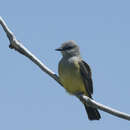en
names in breadcrumbs


A medium-sized (8 inches) flycatcher, the Western Kingbird is most easily identified by its gray head, olive-green back, yellow belly, and black tail with faint white bands on the edges. This species is most easily distinguished from the related Eastern Kingbird (Tyrannus tyrannus) by that species’ darker body and paler breast. Male and female Western Kingbirds are similar to one another in all seasons. The Western Kingbird breeds across much of the western United States, western Mexico, and southwestern Canada, occurring east to the central Great Plains. This species spends the winter in southern Florida, southwestern Mexico, and the Pacific coast of Central America. During migration, individuals may stray far to the north and east of this species’ breeding range, occasionally turning up as far east as the Atlantic seaboard. Western Kingbirds breed in a variety of open and semi-open habitats, including scrubland, fields, and prairie. During the winter, this species utilizes similar habitats in the tropics as it did in temperate regions during the summer. Like most of their relatives, Western Kingbirds primarily eat small flying insects. In appropriate habitat, Western Kingbirds are most easily seen scanning the surrounding area from a prominent perch. These birds hunt by flying out from perches to capture prey in the air, displaying their characteristic black tail and yellow breast as they do so. Western Kingbirds are primarily active during the day.
A medium-sized (8 inches) flycatcher, the Western Kingbird is most easily identified by its gray head, olive-green back, yellow belly, and black tail with faint white bands on the edges. This species is most easily distinguished from the related Eastern Kingbird (Tyrannus tyrannus) by that species’ darker body and paler breast. Male and female Western Kingbirds are similar to one another in all seasons. The Western Kingbird breeds across much of the western United States, western Mexico, and southwestern Canada, occurring east to the central Great Plains. This species spends the winter in southern Florida, southwestern Mexico, and the Pacific coast of Central America. During migration, individuals may stray far to the north and east of this species’ breeding range, occasionally turning up as far east as the Atlantic seaboard. Western Kingbirds breed in a variety of open and semi-open habitats, including scrubland, fields, and prairie. During the winter, this species utilizes similar habitats in the tropics as it did in temperate regions during the summer. Like most of their relatives, Western Kingbirds primarily eat small flying insects. In appropriate habitat, Western Kingbirds are most easily seen scanning the surrounding area from a prominent perch. These birds hunt by flying out from perches to capture prey in the air, displaying their characteristic black tail and yellow breast as they do so. Western Kingbirds are primarily active during the day.
The western kingbird (Tyrannus verticalis) is a large tyrant flycatcher found throughout western environments of North America, as far south as Mexico.
Adults are a combination of both gray and yellow plumage, along with crimson feathers that are hidden until courtship or against intruders. Characteristic of kingbird species, the western kingbird is very territorial. Although the western is often misidentified as Cassin's kingbird, Couch's kingbird, or the tropical kingbird due to the yellow coloration, it can be distinguished from these other species through its black, squared tail with white edges.

The breeding habitat is open areas in western North America. The increased presence of trees throughout the Great Plains during the past century due to fire suppression and tree planting facilitated the range expansion of the western kingbird,[4][5][6] as well as range expansions of many other species of birds.[7][8][9]
The name kingbird is derived from their "take-charge" behavior. These birds aggressively defend their territory, even against much larger birds such as hawks. They will attack humans, livestock, and pets when they think their young are in danger. Kingbirds make a sturdy cup nest in a tree or shrub, sometimes on top of a pole or other man-made structure. Three to five white, creamy, or pinkish eggs with heavy blotches of brown, black, or lavender are laid and incubated for 12 to 14 days.[10] Due to the small size of the nest, and the chicks' rapid rate of growth, most of them are pushed out of the nest, due to overcrowding, before they are fully feathered and able to fly. [2]
They wait on an open perch and fly out to catch insects such as bees, robber flies, winged ants, grasshoppers, and spiders. They are also known to eat berries, buckthorn/sumac, and poison ivy seeds.[11]
These birds migrate in flocks to Florida and the Pacific coast of southern Mexico and Central America.
The song is a squeaky chatter, sometimes compared to a squeaky toy. The call is a sharp loud whit. It occasionally sings before sunrise.
The western kingbird (Tyrannus verticalis) is a large tyrant flycatcher found throughout western environments of North America, as far south as Mexico.